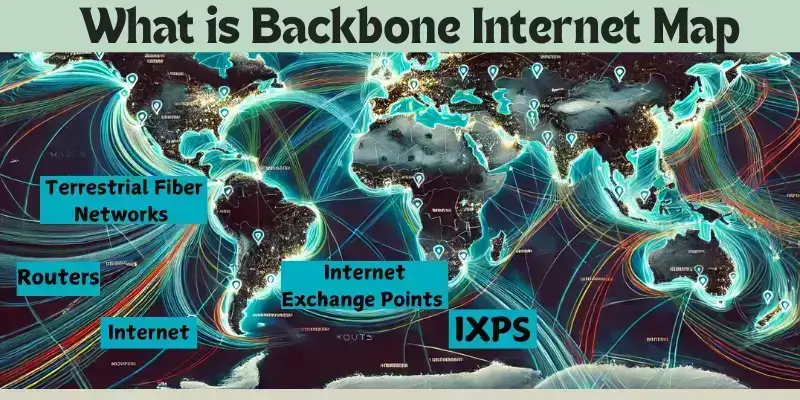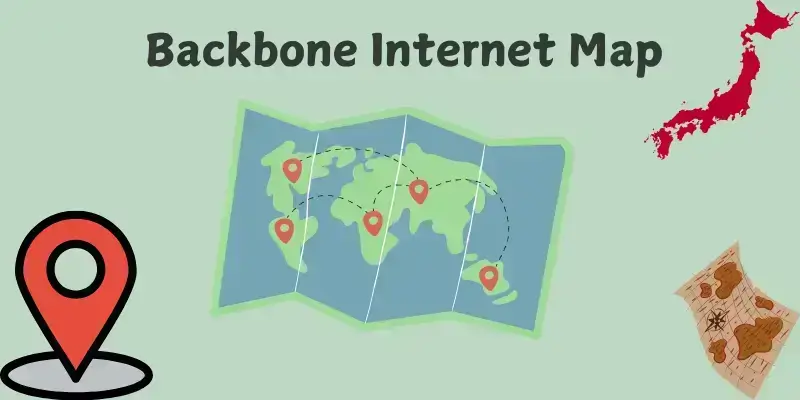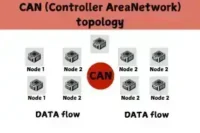What is Backbone Internet Map?
Published: January 31, 2025
Slow internet speeds or interruptions are common problems, but most people don’t realize the infrastructure behind them. The backbone internet map is essential for quickly moving data across different regions. If there’s a disruption in this network, it can lead to significant delays, affecting both businesses and everyday users.

What is a Backbone Internet Map?
The Backbone Internet Map shows the main parts of the Internet’s structure. It highlights key data centers, fiber-optic cables, and connection points that help the Internet run smoothly worldwide. This map helps engineers, businesses, and researchers understand how internet traffic moves and how different parts of the world stay connected.
Importance of Backbone Internet Map

Understanding the backbone internet map is important because it highlights the critical pathways that keep the Internet running. It helps analyze network efficiency, identify congestion points, and improve global connectivity. Businesses, governments, and network engineers rely on this data to optimize internet performance and plan infrastructure upgrades.
This map visualizes global connectivity by showing real-time data traffic flow, key connection points, and how different regions are linked. It also reveals vulnerabilities, such as single points of failure or areas with limited access, helping in disaster recovery planning and cybersecurity strategies.
Key Components of the Backbone Internet Map
1. Tier 1 Networks (Major ISPs like AT&T, Lumen, NTT, etc.)
Tier 1 networks are the largest Internet service providers (ISPs) that form the Internet’s core. They own vast fiber-optic infrastructure and exchange traffic freely without paying other networks. Companies like AT&T, Lumen, and NTT manage global connectivity, ensuring seamless data transfer across regions.
2. Submarine Cables (Connecting Continents Under the Ocean)
Submarine cables are massive fiber-optic networks laid under oceans, connecting continents. They handle nearly 99% of international data traffic, enabling high-speed communication between countries. These cables are crucial in global trade, finance, and communication.
3. Internet Exchange Points (IXPs) (How ISPs Interconnect)
IXPs are physical hubs where multiple ISPs and networks connect to exchange internet traffic efficiently. These hubs reduce latency, lower costs, and improve speed by allowing direct data routing between networks instead of relying on third-party connections.
4. Data Centers & Cloud Infrastructure (Supporting Web Services Globally)
Data centers store and process vast amounts of information, powering websites, applications, and cloud services. Companies like Google, Amazon, and Microsoft operate large cloud infrastructure networks, ensuring fast and reliable internet access for businesses and individuals worldwide.
How the Backbone Internet Map is Structured
1. Continental Backbone Networks (Major Backbones in the US, Europe, Asia, etc.)
Continental backbone networks are high-speed fiber-optic highways connecting countries and regions. The US, Europe, and Asia have densely interconnected networks operated by Tier 1 ISPs. These networks carry vast amounts of data between continents via submarine cables and terrestrial fiber routes.
2. Regional and Local Networks (How Traffic Moves from Backbone to Users)
Regional networks act as middle layers, distributing traffic from the backbone to ISPs and businesses. Local ISPs then deliver internet access to homes, offices, and mobile users. This hierarchical structure ensures efficient traffic flow from global backbones to end-users.
3. Routing & Traffic Management (How Data is Transmitted Efficiently)
Data packets travel through the fastest and most efficient paths using BGP (Border Gateway Protocol) routing protocols. ISPs manage congestion and optimize routes to reduce latency, prevent bottlenecks, and ensure seamless global communication.
Evolution of the Backbone Internet Map
The internet backbone has evolved significantly, from early networks to today’s global infrastructure.
1. Early Internet Backbone Development: ARPANET & NSFNET
ARPANET (1969)
The first network used packet-switching to connect four universities. It laid the foundation for the modern Internet.
NSFNET (1980s-1990s)
A high-speed network for research institutions, which became the US internet backbone in the early ’90s.
2. Growth of Global Fiber-Optic Networks
Fiber-Optic Cables
Replaced copper lines, enabling faster and more reliable global data transfer in the late ’90s and early 2000s.
Undersea Cables
These cables connect continents, facilitating global internet traffic.
3. The Impact of 5G, Cloud Computing, and Satellite Internet
5G (2019-Present)
Launched in 2019, 5G offers ultra-fast speeds and low latency and supports many devices, enhancing mobile and backbone networks.
Cloud Computing
Enables distributed data storage, making internet traffic more efficient and reliable.
Satellite Internet
Companies like SpaceX’s Starlink use satellites to provide high-speed Internet in remote areas, expanding the global backbone.
Importance of the Internet Backbone for Businesses & Users
1. How Websites and Services Rely on Backbone Networks
Websites and online services rely on the internet backbone for seamless operations. They use it to:
Transfer Data
Websites access and send data (text, images, videos) across the internet backbone to users worldwide.
Maintain Availability
A stable backbone ensures websites are always online, supporting everything from e-commerce to streaming services.
Global Reach
Businesses depend on the backbone for customers in different countries to access their services.
2. The Role of CDNs (Content Delivery Networks) in Speeding Up Access
CDNs play a crucial role in enhancing website performance by:
Caching Content
CDNs store copies of website data at multiple locations (edge servers) worldwide, reducing the distance data needs to travel.
Improving Load Times
By delivering content from the closest server, CDNs reduce latency and improve user page load speeds.
Reducing Backbone Strain
CDNs offload traffic from the backbone, helping to manage high volumes of internet requests efficiently.
3. How Backbone Failures or Disruptions Affect the Internet
Disruptions to the backbone can have serious consequences:
Slow Internet Speeds
If a backbone link fails, internet traffic may take longer routes, slowing down data transfer.
Website Downtime
Major websites may go offline or experience performance issues if their connection to the backbone is disrupted.
Global Impact
Since the backbone connects regions and countries, disruptions can cause widespread internet outages or slowdowns.
Challenges and Issues with the Internet Backbone
The internet backbone faces several challenges that can impact its performance and security:
1. Bandwidth & Congestion Issues
Handling Massive Data Traffic:
As internet users and connected devices increase, so does the data traffic across backbone networks. Some key issues include:
Overloaded Links
With growing demand, some network routes can become congested, causing slower speeds and poor connectivity.
Capacity Limits
While fiber-optic cables offer high capacity, some regions still struggle to meet the demands of massive data traffic, especially during peak times.
Solution
Upgrading infrastructure, such as laying more fiber-optic cables and expanding network capacity, helps alleviate congestion and ensures smooth data flow.
2. Cybersecurity Threats
DDoS Attacks on Backbone Infrastructure
Distributed Denial-of-Service (DDoS) attacks are a major threat to the backbone. These attacks flood network resources with malicious traffic, overwhelming them and causing disruptions. When aimed at backbone infrastructure, DDoS attacks can:
Disrupt Services
Essential services may become slow or unavailable during an attack.
Cause Widespread Outages
DDoS attacks targeting key network nodes can affect global internet access.
Solution
Investing in stronger security measures, such as traffic filtering, enhanced monitoring, and more resilient infrastructure, helps mitigate DDoS threats.
3. Geopolitical Conflicts & Control
Who Owns and Controls the Internet Backbone?
Private companies, government agencies, and international organizations own and operate the Internet backbone. It raises concerns about:
Centralized Control
A few major corporations control large portions of the global internet infrastructure, potentially influencing access or policies.
Geopolitical Tensions
Countries may control the backbone to influence global communication or restrict access during conflicts. For example, governments can shut down or limit internet access within their borders for political reasons.
Solution
Balancing global cooperation and regulation is essential to prevent monopolies and ensure equitable access to the Internet.
Conclusion
The internet backbone is crucial for global connectivity, providing fast and reliable access to online services. It has evolved from early networks like ARPANET to modern systems like fiber optics, 5G, and satellite internet. However, bandwidth congestion, cybersecurity threats, and geopolitical control still pose challenges.
The internet backbone map is vital for understanding how global communication works. It highlights the infrastructure that connects people and services worldwide, showing the importance of a secure and efficient network.
Stay informed about changes in internet infrastructure to keep up with technological advancements and ensure smooth, secure online experiences.
FAQS About Backbone Internet Map
A backbone internet map shows the main infrastructure of the internet, like data centers, fiber-optic cables, and interconnection points. It helps us understand how information travels across the globe.
The backbone internet map is important because it shows how internet traffic flows. It helps engineers and businesses identify where problems, like slow speeds, might occur in the network.
No, the backbone internet map focuses on large-scale connections between regions. It doesn’t show your personal home internet or local network.
The backbone internet map impacts speed because it determines how quickly data moves between regions. If there’s a problem in the backbone network, it can slow down your internet.
No, they are different. The backbone internet map is the physical and technical infrastructure of the internet, while the World Wide Web is the content (websites, apps, etc.) we use online.
Major disruptions in the backbone network, like damaged fiber-optic cables or server failures, can be identified using the backbone internet map. It helps engineers locate and fix issues quickly.
Various companies and governments control different parts of the backbone infrastructure. Major internet service providers (ISPs) own and operate many of the backbone’s cables and servers.
Yes, the backbone internet map covers most regions of the world. However, some remote areas may not have direct connections to the global backbone and rely on satellite or other methods.
Public versions of the backbone internet map are available online, although they may not show all the private or secure connections. Some maps are designed for engineers and professionals.
The backbone internet map can help with internet security by identifying potential weak points in the network. Companies can better protect the infrastructure from cyberattacks by knowing where critical connections are.





